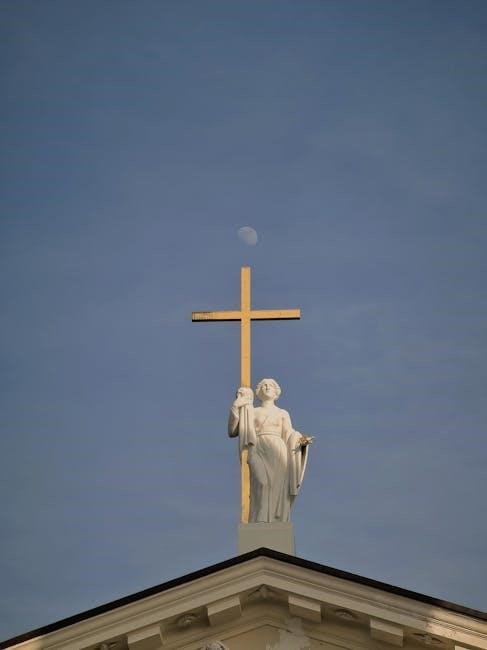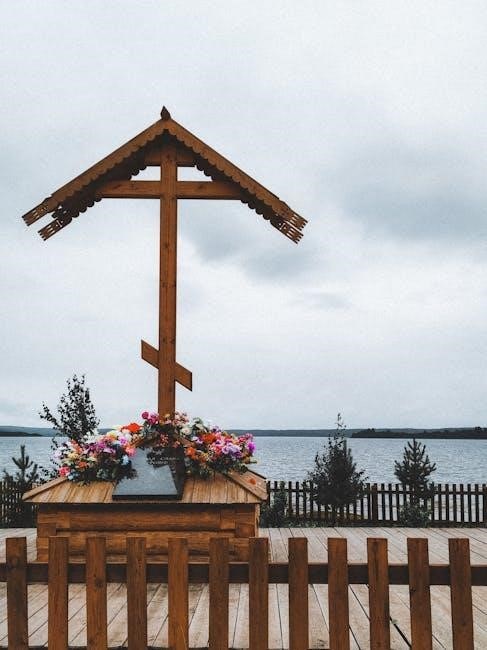The Way of the Cross, or Via Crucis, is a sacred devotion honoring Christ’s Passion, offering spiritual reflection and prayer through 14 stations․ It traces Jesus’ journey to Calvary, fostering deep meditation on His sacrifice and love․ This ancient practice, rooted in Jerusalem, has evolved into a global tradition, with modern resources like PDF guides making it accessible for personal and communal devotion․
Overview of the Devotion
The Way of the Cross, or Stations of the Cross, is a traditional Catholic devotion that commemorates Jesus Christ’s Passion and death․ It consists of 14 stations, each representing a specific event from His condemnation to His burial․ This devotion invites believers to reflect on Christ’s suffering, fostering empathy, gratitude, and spiritual growth․ The stations are often accompanied by prayers, meditations, and hymns, guiding participants through a deeply personal and communal experience․ Originating in Jerusalem, the practice has spread globally, with adaptations for both individual and group observance․ PDF guides and digital resources now make it easier for people to follow the Way of the Cross in their homes or churches, enhancing its accessibility and timeless relevance․
Historical Roots of the Stations of the Cross
The Stations of the Cross trace their origins to early Christian pilgrims visiting Jerusalem, retracing Jesus’ final journey along the Via Dolorosa․ By the 4th century, the Church had established devotional sites at key locations associated with His Passion․ As travel to the Holy Land became difficult, replicas of these sites were created in Europe during the 16th century․ The devotion gained popularity in the 17th century, with the 14 stations becoming a standard format․ This practice, rooted in pilgrimage and reflection, has since become a global tradition, offering believers a tangible way to connect with Christ’s sacrifice and resurrection․ PDF guides now preserve and share this rich history for modern devotees․

The Structure of the Way of the Cross
The Way of the Cross is structured around 14 stations, each representing a significant event in Jesus’ Passion․ These stations, rooted in scripture, guide believers through a meditative journey of reflection and prayer, from Pontius Pilate’s judgment to Christ’s burial, offering a profound connection to His sacrifice and redemption․
The 14 Stations and Their Significance
The 14 Stations of the Cross represent pivotal moments in Jesus’ journey to Calvary, from His condemnation to His burial․ Each station symbolizes a specific event, inviting believers to reflect on Christ’s sacrifice and redemption․ The Stations are deeply rooted in scripture and tradition, offering a structured path for meditation and prayer․ They begin with Jesus’ condemnation by Pontius Pilate and conclude with His burial, emphasizing His unwavering love and obedience․ These stations serve as a visual and spiritual guide, helping devotees connect with the Passion of Christ, fostering empathy, gratitude, and a deeper understanding of His divine love․ The Stations are a cornerstone of Catholic devotion, particularly during Lent, encouraging believers to walk spiritually with Jesus, embracing His journey of sacrifice and redemption․
Scriptural Basis for the Stations

The Stations of the Cross are deeply rooted in Scripture, drawing from key events in the Gospels that narrate Jesus’ Passion and death․ Each station corresponds to specific biblical passages, such as Jesus’ condemnation by Pontius Pilate (John 19:1-16), His meeting with His mother (John 19:25-27), and His death on the cross (John 19:28-37)․ The Stations also incorporate moments like Simon of Cyrene carrying the cross (Mark 15:21) and Veronica wiping Jesus’ face (tradition, not directly in Scripture)․ These events, while not all explicitly detailed in the Bible, are inspired by the narrative of Christ’s journey to Calvary․ The scriptural basis ensures the devotion remains grounded in the life and teachings of Jesus, making it a powerful tool for meditation and reflection during Lent․
Traditional Prayers and Meditations
Traditional prayers and meditations are integral to the Way of the Cross, guiding devotees through reflection on Christ’s Passion․ Common prayers include responses like “Because by Your holy cross, You have redeemed the world” and meditations on specific Gospel events․ These prayers, often recited at each station, deepen the spiritual connection to Christ’s sacrifice․ Many traditions incorporate verses like “Consider how weak and weary Jesus was” to emphasize His suffering․ The prayers are designed to evoke compassion, gratitude, and a commitment to following Christ․ This structured devotion helps individuals and communities unite in prayer, reflecting on the redemptive power of the cross and its significance in Christian faith․

Prayers and Meditations in the Way of the Cross
Prayers and meditations in the Way of the Cross guide devotees to reflect on Christ’s Passion, fostering spiritual growth and a deeper connection to His sacrifice and love․
Traditional Prayers for Each Station
Traditional prayers for each station are integral to the Way of the Cross, offering a structured way to reflect on Christ’s Passion․ These prayers, often recited or sung, guide devotees in meditation, encouraging a deeper connection to the sacrifice of Jesus․ Many prayers are rooted in scripture and Catholic tradition, such as the Stabat Mater or the Psalm 51, emphasizing repentance and compassion․ At each station, specific prayers or hymns are recited, fostering a spiritual journey alongside Christ․ For example, the First Station begins with a prayer for resignation to God’s will, while the Tenth Station reflects on Jesus being stripped of His garments․ These prayers, often included in Way of the Cross PDF guides, provide a meaningful framework for personal or communal devotion, enriching the spiritual experience of the Passion narrative․

Meditations on the Passion of Christ
Meditations on the Passion of Christ are a profound aspect of the Way of the Cross, inviting believers to reflect deeply on Jesus’ suffering and resurrection․ These meditations often focus on the emotional and spiritual dimensions of His journey, emphasizing themes of love, sacrifice, and redemption․ Each station offers a unique opportunity to contemplate the significance of Christ’s actions, from His condemnation to His burial․ Many meditations encourage participants to connect personally with the Passion, fostering empathy and spiritual growth․ The use of scripture, prayer, and reflection guides individuals to embrace the transformative power of Christ’s sacrifice․ Such meditations are frequently included in Way of the Cross PDF guides, providing a meaningful framework for personal or communal devotion during Lent or at any time․
Leading Group Prayers and Reflections
Leading group prayers and reflections during the Way of the Cross requires thoughtful preparation to create a meaningful and engaging experience․ The leader should select appropriate prayers, meditations, and scriptures that align with each station, fostering a deeper connection to Christ’s Passion․ It is important to maintain a solemn and reverent atmosphere, guiding participants through moments of silence, reflection, and communal prayer․ Many Way of the Cross PDF guides provide structured formats for group leadership, including prayers and responses, helping to ensure a smooth and spiritually enriching experience․ Encouraging active participation and heartfelt reflection allows the group to collectively embrace the journey of faith and redemption․
Liturgical Celebrations and the Way of the Cross
The Way of the Cross is deeply integrated into Lenten liturgical celebrations, fostering communal reflection on Christ’s Passion․ It strengthens spiritual connection and faith renewal during Lent․
Role in Lenten Devotions
The Way of the Cross plays a central role in Lenten devotions, serving as a powerful tool for spiritual reflection and penance․ During Lent, Catholics often participate in this devotion to deepen their connection with Christ’s Passion, fostering a sense of communal prayer and solidarity․ The 14 stations provide a structured meditation on the events leading to Christ’s crucifixion and resurrection, encouraging believers to reflect on their own spiritual journeys․ Many parishes organize public Stations of the Cross, often on Fridays, to emphasize the sacrifice and redemption central to the Lenten season․ This practice helps believers prepare for Easter by focusing on the profound meaning of Christ’s suffering and its transformative power in their lives․
Live Enactments and Community Participation
Live enactments of the Way of the Cross have become a vibrant expression of communal faith, engaging participants in a dynamic and immersive experience․ Many parishes and communities organize public processions or reenactments, often during Lent, to bring the Passion of Christ to life․ These events typically involve participants acting out the 14 stations, accompanied by prayers, reflections, and hymns․ Community participation fosters a sense of unity and shared devotion, making the experience more tangible and emotionally impactful․ Families and individuals alike can engage in these events, which often include visual representations and meditative pauses․ Such enactments not only deepen spiritual connection but also strengthen communal bonds, emphasizing the collective journey toward Easter․
Way of the Cross in Catholic Tradition
The Way of the Cross holds a profound place in Catholic tradition, serving as a vivid reminder of Christ’s Passion and sacrifice․ Originating in Jerusalem, the devotion reflects the journey of early Christian pilgrims who retraced Jesus’ path to Calvary․ Over centuries, this practice evolved, with the 14 stations becoming a standard format․ The Catholic Church formalized the tradition, encouraging its adoption worldwide․ Many religious orders, such as the Franciscans, have played a significant role in promoting this devotion․ The Stations of the Cross are deeply rooted in scripture, inviting believers to reflect on key events of Christ’s Passion․ This timeless tradition continues to inspire Catholics globally, offering a meaningful way to connect with the heart of their faith during Lent and beyond․
Theological Significance of the Way of the Cross
The Way of the Cross deeply reflects the theological significance of Christ’s Passion, emphasizing the cross as a symbol of redemption and humanity’s reconciliation through His sacrifice․
Reflections on the Passion and Death of Christ
The Way of the Cross invites believers to deeply reflect on Christ’s Passion, contemplating His suffering, love, and sacrifice․ Through the 14 stations, followers relive the journey from condemnation to resurrection, fostering gratitude and spiritual growth․ The cross, once a symbol of death, becomes a triumph of redemption and divine love․ These reflections inspire compassion, humility, and a commitment to emulate Christ’s selfless love․ Traditional prayers and modern meditations, often found in Way of the Cross PDF guides, provide structured devotion for both personal and communal observance, enriching the spiritual experience and connecting faith with real-life challenges and triumphs․
The Cross as a Symbol of Redemption
The cross, once an instrument of death, became a symbol of redemption through Christ’s sacrifice․ It represents divine love, forgiveness, and victory over sin․ The Way of the Cross highlights the cross as a transformative emblem, turning suffering into salvation․ Through the Stations of the Cross, believers reflect on Christ’s selfless act, embodying the power of redemption․ The cross reminds us of God’s mercy and the promise of eternal life․ Its significance extends beyond history, inspiring hope and renewal in the lives of the faithful․ The cross stands as a universal symbol of redemption, bridging humanity’s brokenness with God’s grace and love․
Spiritual Growth Through the Stations
The Way of the Cross offers a profound path to spiritual growth by inviting believers to meditate on Christ’s Passion․ Each station provides an opportunity to reflect on sin, forgiveness, and divine love․ Through prayer and contemplation, individuals deepen their faith and draw closer to God․ The stations encourage empathy and compassion, fostering a deeper understanding of Christ’s sacrifice․ This devotion helps believers embrace their own crosses, uniting their struggles with Christ’s․ Spiritual growth is further nurtured through acts of self-reflection, repentance, and renewed commitment to following Christ․ The Way of the Cross becomes a transformative journey, guiding believers toward holiness and a closer union with God․
Art and Architecture in the Way of the Cross
The Way of the Cross is often depicted through vivid artwork and architectural designs, with stations visually representing Christ’s journey to Calvary, enhancing devotion and meditation․

Visual Representations of the Stations
The Stations of the Cross are often visually depicted in churches and public spaces through artwork, sculptures, or images․ These representations vividly portray the 14 events of Christ’s Passion, from His condemnation to His burial․ Traditional styles include paintings, mosaics, and carved reliefs, while modern interpretations incorporate digital art and multimedia․ Each station serves as a focal point for meditation, inviting believers to contemplate the sacrifices of Jesus․ The visuals are designed to evoke empathy, reflection, and spiritual connection, making the Passion of Christ accessible and relatable․ These artistic expressions vary across cultures, yet they universally convey the profound message of redemption and divine love․
Traditional and Modern Artistic Interpretations
The Stations of the Cross have been depicted through various artistic styles, blending tradition with contemporary expressions․ Traditional interpretations often feature classical paintings, sculptures, or stained glass, emphasizing sacred symbolism and emotional depth․ Modern artistic interpretations incorporate digital media, abstract designs, and multicultural influences, making the devotion more accessible to diverse audiences․ Both styles aim to evoke a spiritual connection, inviting reflection on Christ’s Passion․ These visual representations not only beautify worship spaces but also serve as powerful tools for meditation, helping the faithful engage deeply with the story of redemption․ Artistic diversity enriches the universal message of the Way of the Cross, ensuring its timeless relevance․
Architectural Layout of Stations in Churches
The Stations of the Cross are typically placed along the walls or perimeter of churches, creating a devotional pathway for worshipers․ This layout mirrors the historical Via Dolorosa in Jerusalem, allowing the faithful to symbolically journey with Christ․ Many churches feature life-sized Stations, often crafted from wood, stone, or metal, enhancing the sacred ambiance․ The architectural design ensures visibility and accessibility, fostering communal prayer and individual reflection․ The placement of Stations near altars or shrines emphasizes their spiritual significance, while natural light or stained glass often highlights the imagery, deepening the contemplative experience․ This traditional arrangement invites believers to walk in Christ’s footsteps, connecting architecture with devotion․

Modern Adaptations of the Way of the Cross
Modern adaptations include digital resources, live streaming, and PDF guides, making the devotion accessible worldwide․ These innovations enhance participation and reflection, blending tradition with technology․
Digital Resources and PDF Guides
Digital resources and PDF guides have made the Way of the Cross more accessible, enabling devotees to reflect on the Passion of Christ anytime and anywhere․ These guides often include prayers, meditations, and images of the 14 stations, providing a comprehensive experience․ Many Catholic communities and websites offer downloadable PDF versions, allowing individuals to follow the devotion privately or in groups․ These resources are particularly useful during Lent, when the Way of the Cross is a popular practice․ They also cater to diverse needs, offering versions tailored for families, children, and those seeking deeper theological insights․ Digital platforms have thus revitalized this ancient tradition, ensuring its relevance in a modern, tech-driven world․

Contemporary Meditations and Reflections
Contemporary meditations and reflections on the Way of the Cross offer fresh perspectives, connecting the ancient devotion to modern life․ Many PDF guides now include prayers and reflections that address current challenges, such as social justice, personal struggles, and global issues․ These resources encourage believers to see Christ’s Passion as a call to compassion and action․ Reflections often emphasize the universal themes of love, sacrifice, and redemption, making the Way of the Cross relevant to today’s world․ By blending traditional prayers with modern insights, these meditations help individuals and communities deepen their spiritual connection to Christ’s journey, fostering personal growth and communal solidarity․
Live Streaming of the Way of the Cross

Live streaming of the Way of the Cross has become a modern adaptation of this ancient devotion, allowing global participation․ Many churches and communities broadcast their Stations of the Cross ceremonies online, enabling those unable to attend in person to join spiritually․ This practice has grown significantly during Lent, especially in recent years, to accommodate diverse audiences․ Some streams include interactive elements, such as virtual candles or shared prayers, fostering a sense of unity among participants․ Pope Francis has also embraced this technology, leading global Way of the Cross events that millions can follow online․ This innovation ensures the timeless devotion remains accessible and engaging for all, regardless of location or circumstance․

Personal and Communal Reflection
The Way of the Cross invites individuals and communities to reflect deeply on Christ’s Passion through meditation and prayer, fostering spiritual connection and shared devotion․
Individual Prayer and Meditation Practices
Individual prayer and meditation practices are central to the Way of the Cross, allowing personal reflection on Christ’s Passion․ Many use PDF guides to follow the 14 stations, pausing at each to pray and contemplate the significance of Jesus’ journey․ These guides often include scripture passages, traditional prayers, and meditative reflections, fostering a deeper connection to the events of Good Friday; Silence and introspection are encouraged, helping individuals to internalize the sacrifice and love embodied in the Cross․ This personal devotion strengthens faith and invites believers to apply the lessons of Christ’s Passion to their daily lives, fostering spiritual growth and renewal․
By engaging with the Way of the Cross individually, one can experience a profound encounter with the divine, even in private settings, making it a versatile and meaningful practice for all․
Family-Friendly Stations of the Cross
Family-friendly Stations of the Cross adaptations make this devotion accessible to children and adults alike, fostering shared spiritual growth․ Many PDF guides now include simplified language, illustrations, and age-appropriate reflections, helping families engage with Christ’s Passion․ These resources often feature stories, prayers, and discussions tailored for younger participants, making the journey meaningful and relatable․ Parents can guide their children through the 14 stations, using visual aids and interactive elements to deepen understanding․ This practice not only strengthens family bonds but also instills faith and compassion in the next generation․ By participating together, families can reflect on the love and sacrifice of Christ, creating a lasting spiritual connection;
Such adaptations ensure the Way of the Cross remains a vibrant and inclusive devotion for all ages․
Community Participation and Shared Devotion
Community participation in the Way of the Cross strengthens faith and unity among believers․ Many parishes organize group prayers, live enactments, and shared reflections, fostering a collective spiritual experience․ These events, often held during Lent, bring people together to walk the Stations of the Cross, fostering a sense of solidarity and shared devotion․ Families, youth groups, and entire congregations can engage in this practice, making it a powerful tool for communal worship․ The shared experience of meditating on Christ’s Passion deepens understanding and connection among participants, creating a bond rooted in faith and mutual support․ This collective journey enriches individual and communal spiritual growth, emphasizing the universal call to follow Christ’s example of love and sacrifice․
The Way of the Cross remains a profound spiritual journey, guiding believers through Christ’s Passion․ Its enduring significance lies in its ability to deepen faith and foster redemption, offering timeless devotion for all․
The Enduring Significance of the Way of the Cross
The Way of the Cross holds profound spiritual significance, offering a deeply personal connection to Christ’s Passion․ It invites believers to reflect on His sacrifice, fostering compassion and gratitude․ Through its 14 stations, this devotion provides a structured path for meditation, helping individuals confront sin and seek redemption․ The practice transcends time, uniting the faithful across generations in a shared experience of faith․ Its adaptability, including modern formats like PDF guides, ensures its relevance in contemporary spirituality․ Ultimately, the Way of the Cross remains a powerful tool for spiritual growth, reminding us of God’s infinite love and the transformative power of Christ’s resurrection․
Practical Guide to Observing the Stations
To observe the Way of the Cross meaningfully, begin by preparing spiritually through prayer and reflection․ Use a guide, such as a Way of the Cross PDF, to follow the 14 stations․ At each station, pause to read the scripture, pray the associated prayer, and meditate on the event․ Encourage group participation by leading others in reciting traditional prayers or sharing personal reflections․ For personal devotion, consider walking the stations in a church or at home, using visuals or icons for focus․ Emphasize humility and gratitude, seeking to connect deeply with Christ’s sacrifice․ Conclude with a hymn or silent prayer, allowing the experience to inspire spiritual growth and renewal․
